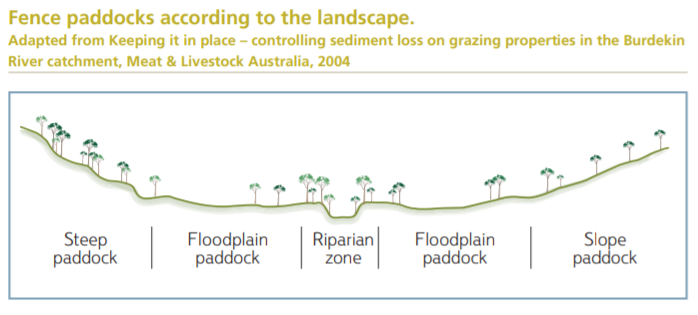Soil erosion is not only a threat to agriculture’s productivity but a major environmental threat to sustainability.
Soil is a natural resource that may look robust and endless, but is in fact the fragile product of thousands of years of formation especially the highly weathered south western Australian soils. Topsoil, which lies closest to the surface of the land, contains essential nutrients for crops and native plants. It is this layer of soil that is endangered by wind and water erosion.
Soil erosion decreases soil fertility, which can negatively affect crop yields. It also sends soil-laden water downstream, which can create heavy layers of sediment potentially chocking the downstream estuary or that prevent streams and rivers from flowing smoothly and can eventually lead to flooding. Once soil erosion occurs, it is more likely to happen again.
Financial losses incurred by soil erosion, and the cost of fixing it, mean that erosion prevention is a much better option than remediation.
The 3 main principles to control erosion are to:
Soil is a natural resource that may look robust and endless, but is in fact the fragile product of thousands of years of formation especially the highly weathered south western Australian soils. Topsoil, which lies closest to the surface of the land, contains essential nutrients for crops and native plants. It is this layer of soil that is endangered by wind and water erosion.
Soil erosion decreases soil fertility, which can negatively affect crop yields. It also sends soil-laden water downstream, which can create heavy layers of sediment potentially chocking the downstream estuary or that prevent streams and rivers from flowing smoothly and can eventually lead to flooding. Once soil erosion occurs, it is more likely to happen again.
Financial losses incurred by soil erosion, and the cost of fixing it, mean that erosion prevention is a much better option than remediation.
The 3 main principles to control erosion are to:
- use land according to its capability
- protect the soil surface with some form of cover
- control runoff before it develops into an erosive force.
Land capability
Soil erosion can be avoided by using land within its capability.
The land’s position, soil type and slope determine how vulnerable it will be to erosion. It may not be suitable for agriculture, or suitable only for an activity which limits erosion. To examine your soil in particular, compare your data and examine soil relationships we recommend using tools provided on www.soilquality.org.au/.
Soil erosion can be avoided by using land within its capability.
The land’s position, soil type and slope determine how vulnerable it will be to erosion. It may not be suitable for agriculture, or suitable only for an activity which limits erosion. To examine your soil in particular, compare your data and examine soil relationships we recommend using tools provided on www.soilquality.org.au/.
Surface cover
Surface cover is a major factor to control erosion because it reduces the impact of raindrops falling on bare soils and wind removing soil particles. It also reduces the speed of water flowing over the land. Erosion risk is significantly reduced when there is more than 30% soil cover. Total cover is achievable for many grazing and cropping systems if managed carefully.
The best way to maintain good groundcover is to select plants that are well adapted to the climate, the soil and the farming system, so that they persist without a lot of attention. You also need to look at your management practices to limit actions that ; high traffic (animal and machinery), tillage, over-grazing, fire etc. where possible/where the soil is vulnerable to erosion.
Surface cover is a major factor to control erosion because it reduces the impact of raindrops falling on bare soils and wind removing soil particles. It also reduces the speed of water flowing over the land. Erosion risk is significantly reduced when there is more than 30% soil cover. Total cover is achievable for many grazing and cropping systems if managed carefully.
The best way to maintain good groundcover is to select plants that are well adapted to the climate, the soil and the farming system, so that they persist without a lot of attention. You also need to look at your management practices to limit actions that ; high traffic (animal and machinery), tillage, over-grazing, fire etc. where possible/where the soil is vulnerable to erosion.
Effective management practices you can use:
- Encourage plant roots
- Match stock numbers to pasture availability
- Rest pastures from grazing
- Minimise compaction
- Fence paddocks according to erodibility
- Have several shaded areas
- Prevent stock tracks forming
- Slash rather than burn
Runoff Management
Landholder should have a drainage plan that potentially includes:
• drainage and discharge of excess runoff into water body i.e. dam or wetland
• problem areas such as waterlogged spots and steep areas
• location of planting areas
• tree row orientation (planned and existing)
• windbreak location
• design and location of access tracks
• location of existing infrastructure.
Landholder should have a drainage plan that potentially includes:
• drainage and discharge of excess runoff into water body i.e. dam or wetland
• problem areas such as waterlogged spots and steep areas
• location of planting areas
• tree row orientation (planned and existing)
• windbreak location
• design and location of access tracks
• location of existing infrastructure.
Read more:
Saving soil: A landholder’s guide to preventing and repairing soil erosion
Wind erosion in WA, Department of Primary Industries and Regional Development
Water erosion in WA, Department of Primary Industries and Regional Development
Sediment in streams 2000 Water note
Role of sediments in nutrient cycling
Sediment quality in three south-western Australian estuaries : a technical report for the project : Tracking acid sulphate soils on the WA coast 2010
River Restoration Manual No.10 Stream stabilisation.
Water Note 18: Livestock management – fence location and grazing control,
Waternote 19: Flood proofing fencing for waterways,
Water note 6: Livestock management – construction of livestock crossings
Waternote 7: Livestock management – watering points and pumps
Saving soil: A landholder’s guide to preventing and repairing soil erosion
Wind erosion in WA, Department of Primary Industries and Regional Development
Water erosion in WA, Department of Primary Industries and Regional Development
Sediment in streams 2000 Water note
Role of sediments in nutrient cycling
Sediment quality in three south-western Australian estuaries : a technical report for the project : Tracking acid sulphate soils on the WA coast 2010
River Restoration Manual No.10 Stream stabilisation.
Water Note 18: Livestock management – fence location and grazing control,
Waternote 19: Flood proofing fencing for waterways,
Water note 6: Livestock management – construction of livestock crossings
Waternote 7: Livestock management – watering points and pumps
We acknowledge the Minang and Koreng people as the traditional custodians of the land on which we work and live. We pay our respects to the Elders, past, present, and emerging and to the wider Noongar community.
Sponsors and Supporters














